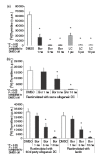Proteasome inhibition suppresses essential immune functions of human CD4+ T cells
- PMID: 18217957
- PMCID: PMC2566628
- DOI: 10.1111/j.1365-2567.2007.02761.x
Proteasome inhibition suppresses essential immune functions of human CD4+ T cells
Abstract
The proteasome constitutes the central proteolytic component of the highly conserved ubiquitin-proteasome system, which is required for the maintenance and regulation of basic cellular processes, including differentiation, proliferation, cell cycling, gene transcription and apoptosis. Here we show that inhibition of proteasomal proteolytic activity by the proteasome inhibitors bortezomib and lactacystin suppresses essential immune functions of human CD4(+) T cells activated by allogeneic dendritic cells (DCs). In activated CD4(+) T cells, proteasome inhibition induces apoptosis accompanied by rapid accumulation and stabilization of the tumour suppressor protein p53. Activated CD4(+) T cells surviving proteasome inhibition undergo inhibition of proliferation by induction of G(1) phase cell-cycle arrest. Induction of G(1) arrest is accompanied by the accumulation of cyclin-dependent kinase inhibitors p21(WAF1/CIP1) and p27(KIP1) and the disappearance of cyclin A, cyclin D2 and proliferating cell nuclear antigen, proteins known to regulate G(1) to S phase cell-cycle transitions. Expression of the activation-associated cell surface receptors CD25, CD28, CD120b and CD134 as well as production of interferon-gamma (IFN-gamma), tumour necrosis factor-alpha (TNF-alpha), interleukin-4 (IL-4) and IL-5 is suppressed in response to proteasome inhibition in CD4(+) T cells activated by DCs. Expression of CD25, IFN-gamma, TNF-alpha, IL-4 and IL-5 is known to be mediated by the transcriptional activity of nuclear factor of activated T cells (NFAT), and we show here that proteasome inhibition suppresses activation and nuclear translocation of NFATc2 in activated CD4(+) T cells. Thus, the proteasome is required for essential immune functions of activated CD4(+) T cells and can be defined as a molecular target for the suppression of deregulated and unwanted T-cell-mediated immune responses.
Figures







Similar articles
-
Helenalin suppresses essential immune functions of activated CD4+ T cells by multiple mechanisms.Mol Immunol. 2009 Sep;46(15):2892-901. doi: 10.1016/j.molimm.2009.07.004. Epub 2009 Aug 5. Mol Immunol. 2009. PMID: 19656571
-
Proteasomal chymotrypsin-like peptidase activity is required for essential functions of human monocyte-derived dendritic cells.Immunology. 2007 Jan;120(1):120-32. doi: 10.1111/j.1365-2567.2006.02487.x. Epub 2006 Nov 3. Immunology. 2007. PMID: 17083604 Free PMC article.
-
Protease inhibitor-induced apoptosis: accumulation of wt p53, p21WAF1/CIP1, and induction of apoptosis are independent markers of proteasome inhibition.Leukemia. 2000 Jul;14(7):1276-83. doi: 10.1038/sj.leu.2401812. Leukemia. 2000. PMID: 10914553
-
The proteasome and its inhibitors in immune regulation and immune disorders.Crit Rev Immunol. 2006;26(6):487-98. doi: 10.1615/critrevimmunol.v26.i6.20. Crit Rev Immunol. 2006. PMID: 17341190 Review.
-
Proteasome: an emerging target for cancer therapy.Anticancer Drugs. 2005 Jun;16(5):475-81. doi: 10.1097/00001813-200506000-00002. Anticancer Drugs. 2005. PMID: 15846112 Review.
Cited by
-
Human Bocavirus Type-1 Capsid Facilitates the Transduction of Ferret Airways by Adeno-Associated Virus Genomes.Hum Gene Ther. 2017 Aug;28(8):612-625. doi: 10.1089/hum.2017.060. Epub 2017 May 10. Hum Gene Ther. 2017. PMID: 28490200 Free PMC article.
-
Bortezomib Improves Adoptive T-cell Therapy by Sensitizing Cancer Cells to FasL Cytotoxicity.Cancer Res. 2015 Dec 15;75(24):5260-72. doi: 10.1158/0008-5472.CAN-15-0794. Epub 2015 Oct 22. Cancer Res. 2015. PMID: 26494122 Free PMC article.
-
The chromosome-scale genome of the raccoon dog: Insights into its evolutionary characteristics.iScience. 2022 Sep 15;25(10):105117. doi: 10.1016/j.isci.2022.105117. eCollection 2022 Oct 21. iScience. 2022. PMID: 36185367 Free PMC article.
-
On the role of the immunoproteasome in transplant rejection.Immunogenetics. 2019 Mar;71(3):263-271. doi: 10.1007/s00251-018-1084-0. Epub 2018 Sep 15. Immunogenetics. 2019. PMID: 30220008 Review.
-
Proteostasis in T cell aging.Semin Immunol. 2023 Nov;70:101838. doi: 10.1016/j.smim.2023.101838. Epub 2023 Sep 12. Semin Immunol. 2023. PMID: 37708826 Free PMC article. Review.
References
-
- Hershko A, Ciechanover A. The ubiquitin system. Annu Rev Biochem. 1998;67:425–79. - PubMed
-
- Glickman MH, Ciechanover A. The ubiquitin–proteasome proteolytic pathway: destruction for the sake of construction. Physiol Rev. 2002;82:373–428. - PubMed
-
- Naujokat C, Hoffmann S. Role and function of the 26S proteasome in proliferation and apoptosis. Lab Invest. 2002;82:965–80. - PubMed
-
- Ciechanover A. The ubiquitin proteolytic system. Neurology. 2006;66(Suppl. 1):S7–19. - PubMed
-
- Baumeister W, Walz J, Zühl F, Seemüller E. The proteasome: paradigm of a self-compartmentalizing protease. Cell. 1998;92:367–80. - PubMed
MeSH terms
Substances
LinkOut - more resources
Full Text Sources
Other Literature Sources
Medical
Research Materials
Miscellaneous

